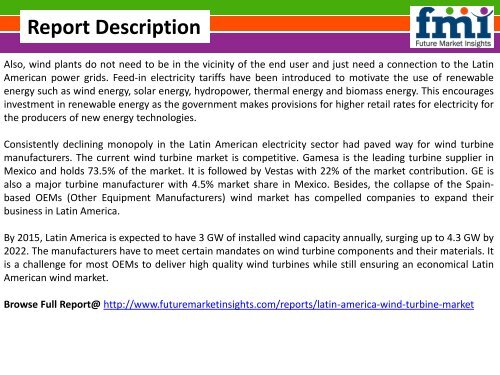Wind Turbine Market Value Share, Supply Demand, share and Value Chain 2014-2020
Wind energy is the power extracted from wind using wind turbines. A wind turbine is a device that transforms the kinetic energy of the wind into electrical energy. Wind energy is a renewable form of energy that is available in ample quantity and extensively. It is an alternative to fossil fuels which are depleting in quantity. Wind energy is the cleanest resource; it has neither toxic gas emissions nor greenhouse gas emissions. Wind turbines are connected to the network of electricity transmission. The onshore and offshore wind that is trapped is an inexpensive, competitive and significant source of energy. Wind energy contributed to 4% of the total global electricity usage in 2013.
Wind energy is the power extracted from wind using wind turbines. A wind turbine is a device that transforms the kinetic energy of the wind into electrical energy. Wind energy is a renewable form of energy that is available in ample quantity and extensively. It is an alternative to fossil fuels which are depleting in quantity. Wind energy is the cleanest resource; it has neither toxic gas emissions nor greenhouse gas emissions. Wind turbines are connected to the network of electricity transmission. The onshore and offshore wind that is trapped is an inexpensive, competitive and significant source of energy. Wind energy contributed to 4% of the total global electricity usage in 2013.
You also want an ePaper? Increase the reach of your titles
YUMPU automatically turns print PDFs into web optimized ePapers that Google loves.
Report Description<br />
Also, wind plants do not need to be in the vicinity of the end user <strong>and</strong> just need a connection to the Latin<br />
American power grids. Feed-in electricity tariffs have been introduced to motivate the use of renewable<br />
energy such as wind energy, solar energy, hydropower, thermal energy <strong>and</strong> biomass energy. This encourages<br />
investment in renewable energy as the government makes provisions for higher retail rates for electricity for<br />
the producers of new energy technologies.<br />
Consistently declining monopoly in the Latin American electricity sector had paved way for wind turbine<br />
manufacturers. The current wind turbine market is competitive. Gamesa is the leading turbine supplier in<br />
Mexico <strong>and</strong> holds 73.5% of the market. It is followed by Vestas with 22% of the market contribution. GE is<br />
also a major turbine manufacturer with 4.5% market <strong>share</strong> in Mexico. Besides, the collapse of the Spainbased<br />
OEMs (Other Equipment Manufacturers) wind market has compelled companies to exp<strong>and</strong> their<br />
business in Latin America.<br />
By 2015, Latin America is expected to have 3 GW of installed wind capacity annually, surging up to 4.3 GW by<br />
2022. The manufacturers have to meet certain m<strong>and</strong>ates on wind turbine components <strong>and</strong> their materials. It<br />
is a challenge for most OEMs to deliver high quality wind turbines while still ensuring an economical Latin<br />
American wind market.<br />
Browse Full Report@ http://www.futuremarketinsights.com/reports/latin-america-wind-turbine-market

















